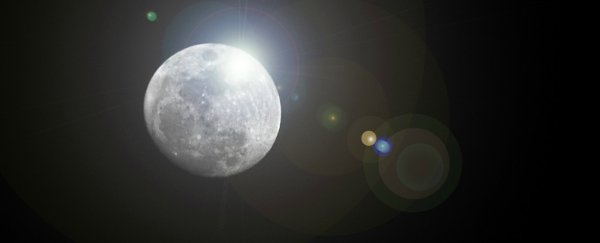Thanks to rocks collected during the Apollo 14 mission, researchers say they've finally pinpointed the exact age of the Moon, and it turns out, our lunar neighbour is an incredible 4.51 billion years old.
These findings suggest that the Moon was formed roughly 60 million years after the Solar System first formed, making it up to 140 million years older than previous estimates.
"Establishing the age of the Moon is critical to understanding Solar System evolution and the formation of rocky planets, including Earth. However, despite its importance, the age of the Moon has never been accurately determined," reports the team, led by Melanie Barboni from the University of California, Los Angeles.
In case you need a refresher, the Moon is thought to have formed from the leftover matter that was sheared off Earth after a collision with Theia - a planet-sized object that existed in the early Solar System - or perhaps a bunch of smaller objects.
The impact that formed the Moon could have been large enough to wipe out any living thing on Earth, so knowing when that collision occurred is important if we hope to understand the evolution of our own planet, and when early life took root here.
And the new research suggests that it happened earlier in the timeline of the Solar System than we thought - just 60 million years after our star system's birth, compared to previous estimates of 150 to 200 million years afterwards.
To come up with the new lunar age estimate, the team analysed Moon rocks taken from the lunar surface during the Apollo 14 mission.
The reason we've never been able to accurately date the age of the Moon in the past is that there's very few well-preserved Moon rocks left on its surface.
Most of the rocks brought back by Apollo astronauts are breccias - mixes of different rocks that have been mashed together by the meteorite strikes that plague the Moon, thanks to its lack of atmosphere.
So instead of trying to find chunks of rock that had been there since the early days, the team instead turned to zircon - a mineral that would have formed as the Moon was cooling from its fresh, molten state into the rocky satellite we see today.
Once formed, zircon crystals stay perfectly intact as little time signatures of geological events. Studying zircon allows researchers to see when parts of the rock solidified, which is exactly what they needed to figure out when the Moon had fully formed.
"This mineral is just the king when you try to understand any processes, because it is amazingly sturdy," Barboni told Loren Grush at The Verge.
The team performed a process known as uranium-lead dating on zircon samples that were extracted from the Apollo 14 space rocks.
This required them to liquefy the zircon samples in acid, destroying the space rock artefacts.
But inside the zircon, the team was able to pull out four different elements: uranium, lead, lutetium, and hafnium.
Since uranium - a radioactive element - eventually turns into lead after long periods of time, the researchers could analyse how long the lead had been forming, giving them an accurate date of the Moon's birth.
The ratios of lutetium and hafnium in the zircon also indicated how long the mineral had been around for.
Combining these analytical techniques, the team found that the Moon is 4.51 billion years old, making it far older than we previously thought, and providing us with a more accurate picture of how our Solar System formed.
"The evolution of Earth could only have started after this impact," Barboni told The Verge. "And that's why it's so important to date this impact, because you want to know when Earth started to evolve into the beautiful planet we all know today."
While the new measurement is the most precise to date, some outside researchers have said that the act of dissolving the zircon in acid might have changed some of the results slightly, but Barboni says they accounted for these concerns.
"We were able to correct for everything that was a problem before, the reasons people said zircon couldn't be used," she told Mike Wall at Space.com.
Hopefully, as these measurements become more and more precise, we will gain a full understanding of how the Moon - and the rest of the Solar System - formed, giving us more details about life on Earth, and the possibility of life on other planets.
The study has been published in Science Advances.
